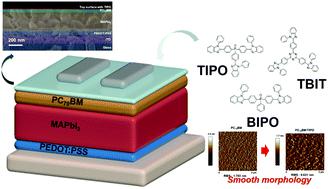当前位置:
X-MOL 学术
›
J. Mater. Chem. C
›
论文详情
Our official English website, www.x-mol.net, welcomes your
feedback! (Note: you will need to create a separate account there.)
Tris(4-(1-phenyl-1H-benzo[d]imidazole)phenyl)phosphine oxide for enhanced mobility and restricted traps in photovoltaic interlayers
Journal of Materials Chemistry C ( IF 5.7 ) Pub Date : 2021-2-8 , DOI: 10.1039/d0tc06049f Jihyun Lim 1, 2, 3, 4 , Do-Yeong Choi 5, 6, 7, 8 , Woongsik Jang 1, 2, 3, 4 , Hyeon-Ho Choi 5, 6, 7, 8 , Yun-Hi Kim 4, 6, 9, 10 , Dong Hwan Wang 1, 2, 3, 4
Journal of Materials Chemistry C ( IF 5.7 ) Pub Date : 2021-2-8 , DOI: 10.1039/d0tc06049f Jihyun Lim 1, 2, 3, 4 , Do-Yeong Choi 5, 6, 7, 8 , Woongsik Jang 1, 2, 3, 4 , Hyeon-Ho Choi 5, 6, 7, 8 , Yun-Hi Kim 4, 6, 9, 10 , Dong Hwan Wang 1, 2, 3, 4
Affiliation

|
Among small molecule organic materials, tris(4-(1-phenyl-1H-benzo[d]imidazole)phenyl)phosphine oxide (TIPO) and 2,4,6-tris(4-(1-phenyl-1H-benzo[d]imidazol)phenyl)-1,3,5-triazine were newly synthesised and introduced into an n-type interlayer in planar perovskite solar cells for effective electron transport. The small molecule materials contain phenyl benzimidazole, which is combined with a phosphine oxide core or a triazine ring core and contributes to the improvement of charge extraction and stability. As the constituent molecules—phosphine oxide and benzimidazole—have strong polarity properties and π-electrons, the molecules induce passivating defects towards improving charge transport and flattening the surface morphology. Moreover, the stability of the device was increased due to the introduction of the TIPO material as the passivation and protection layer. In this electron extraction analysis, electrical resistance and surface morphology investigations were carried out via space charge-limited current, photoluminescence, impedance, and atomic force microscopy analyses.
中文翻译:

三(4-(1-苯基-1H-苯并[d]咪唑)苯基)膦氧化物可提高迁移率并限制光伏中间层中的陷阱
间小分子有机材料,三(4-(1-苯基-1- ħ -苯并[ d ]咪唑)苯基)氧化膦(TIPO)和2,4,6-三(4-(1-苯基-1- ħ -苯并[ d新合成了]咪唑醇)苯基)-1,3,5-三嗪并将其引入平面钙钛矿太阳能电池的n型中间层中以有效地进行电子传输。所述小分子材料包含苯基苯并咪唑,其与氧化膦核或三嗪环核结合并有助于改善电荷提取和稳定性。由于组成分子(氧化膦和苯并咪唑)具有很强的极性和π电子,这些分子会引起钝化缺陷,从而改善电荷传输并使表面形态变平。此外,由于引入了TIPO材料作为钝化和保护层,因此提高了设备的稳定性。在该电子提取分析中,进行了电阻和表面形态研究通过空间电荷限制电流,光致发光,阻抗和原子力显微镜分析。
更新日期:2021-02-23
中文翻译:

三(4-(1-苯基-1H-苯并[d]咪唑)苯基)膦氧化物可提高迁移率并限制光伏中间层中的陷阱
间小分子有机材料,三(4-(1-苯基-1- ħ -苯并[ d ]咪唑)苯基)氧化膦(TIPO)和2,4,6-三(4-(1-苯基-1- ħ -苯并[ d新合成了]咪唑醇)苯基)-1,3,5-三嗪并将其引入平面钙钛矿太阳能电池的n型中间层中以有效地进行电子传输。所述小分子材料包含苯基苯并咪唑,其与氧化膦核或三嗪环核结合并有助于改善电荷提取和稳定性。由于组成分子(氧化膦和苯并咪唑)具有很强的极性和π电子,这些分子会引起钝化缺陷,从而改善电荷传输并使表面形态变平。此外,由于引入了TIPO材料作为钝化和保护层,因此提高了设备的稳定性。在该电子提取分析中,进行了电阻和表面形态研究通过空间电荷限制电流,光致发光,阻抗和原子力显微镜分析。






























 京公网安备 11010802027423号
京公网安备 11010802027423号